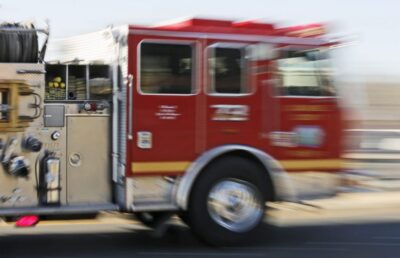One by one, puppies who are en route to becoming service dogs boarded, rode and exited Santa Clarita buses on Saturday in order to become familiarized with public transportation.
As a part of the fifth annual Transportation Day hosted by The Guide Dogs of America — Tender Loving Canines and city of Santa Clarita Transit, about 40 puppies experienced wheelchair lift exposure, walked on bus ramps and stairs and became familiar with the hydraulic noises at the Santa Clarita Metrolink Station from 9 a.m. to noon.
Puppies ages 4 months to 2 years rode the city’s commuter buses, transit buses and even the Dial-A-Ride access buses.
“The puppies in training are working on their basics, their socialization, in preparation for them to come in anywhere between 16 to 18 months old, where they’ll either become guide dogs for the visually impaired, service dogs for veterans with PTSD and children with autism, or facility dogs, who [work with first responders],” said Vikki Tonge, canine development assistant for The Guide Dogs of America — Tender Loving Canines.

According to Tonge, various volunteers began training and raising the puppies, which are typically Labrador retrievers and bred in-house by the organization, as early as 8 weeks old.
“Everyone that has a puppy that you see today is a volunteer — our organization is all run by volunteers. They basically volunteer their time, their home, their love, their training, all that kind of stuff to raise these puppies. They’ll get the puppies around 8 weeks old,” Tonge said. “They’re supported by area leaders, who are volunteers that help with different areas of canine development, such as training, puppy kindergartens, outings, evaluations. They get a lot of support, until they come back to our campus in Sylmar for guide dog training.”
While the terms “guide” and “service” dogs may be used interchangeably, there is a difference, according to Tonge.
“Guide dogs are service dogs, but service dogs aren’t necessarily guide dogs. So the umbrella of a service dog is a dog that is trained to perform a task for someone with a disability or a health concern. Guide dogs specifically, are the seeing eye dogs. They’re the ones for the visually impaired, and they will basically help them navigate the world,” Tonge said. “We don’t know [if the puppies] go to guide or service yet because they’re still in training. That’s kind of the fun thing.”
Indicators on whether the dogs will be guide or service dogs depend on their personalities, and whether they’re more independent or personable.
“From personal experience, the dogs that tend to be more independent and headstrong tend to make better guide dogs, because the guide dogs have to be able to assess the environment for the visually impaired, and have to make decisions for themselves,” Tonge said. “Service dogs, on the other hand, while we definitely want very confident dogs, can also be a little bit more clowny because they’re going to have someone that’s working with them, kind of telling them, ‘Hey, I need this, and hey, I need that.’ But they still need to understand if someone is having a panic attack.”

Pam English, area leader in Santa Clarita, focused on training 4-month-old Nanook by teaching her to go up the stairs of the Dial-A-Ride bus.
“We’ve been doing this before the pandemic. It’s pretty neat to be able to offer this type of thing. It’s one thing to get on a bus and ride it, but it’s another thing for a young puppy to be exposed slowly to it,” English said. “It’s not so much a ride as it is that we’re going to be boarding, exiting, listening to hydraulics, watching the ramps come down and go up, encountering different passengers.”
She added: “The city’s so good. They said, ‘Yeah, if you want one bus just to take rides around you can do that, if you want all three to take rides around, you could do that. Up to you for the rest of the day.’”








